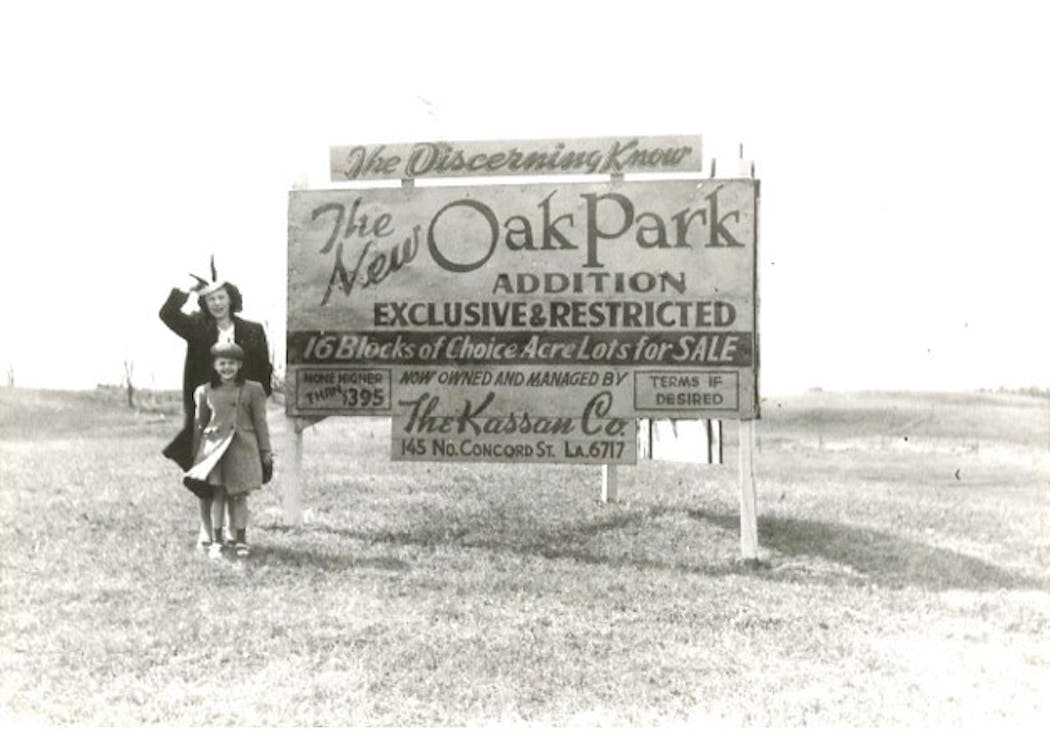Housing deeds were issued many decades ago that barred people of color from living in parts of Dakota County, according to new data just released to the Dakota County Board.
The research, conducted by Mapping Prejudice, an organization based at the University of Minnesota, is believed to be the first comprehensive look at racial covenants in a suburban county in the United States, according to Project Director Kirsten Delegard.
"I think a lot of us make assumptions of why our communities look the ways that they do," said County Board Member Laurie Halverson. "When you look at the policies of racial covenants and redlining, it was a choice to prevent Black people and people of color" from living in the community.
Sections of South St. Paul, West St. Paul, Mendota Heights and Lakeville show housing tracts with deeds containing racial covenants that explicitly require homeowners to sell only to white people.
Board Member Joe Atkins spotted an address on Earl Lane in South St. Paul, where his father and grandfather once lived, that carried a deed with a racial covenant.
"My father would have been mortified," said Atkins.
Delegard said she's certain this is the first time a suburban county is being thoroughly investigated for racial covenants. Her organization is part of a nationwide network of researchers that regularly meets to exchange information.
"People have assumed that racial covenants were only in the urban core," said Delegard. "What our research is showing is that they are in all of the suburbs, and we are finding it in the rural areas."
Formed in 2016, Mapping Prejudice has completed research on racial covenants in Hennepin County, where it found 24,000 covenants. It's winding up research on Ramsey County, where it has located 5,500 so far.
About a third of the housing records of Dakota County have thus far been analyzed, and 560 deeds with racial covenants have been found; Michael Corey, who heads the technical work for Mapping Prejudice, said it would be unwise to extrapolate a final count from that number. Recent census data shows about 135,000 owner-occupied homes in Dakota County.
Mapping Prejudice hopes to complete its work on Dakota County by year's end, and in the meantime launch a covenant inquiry into Anoka County this fall. It intends to map racial covenant data for all seven metro counties, and is starting to collaborate with groups in Rochester and St. Cloud to research those communities. It has also uncovered racial covenants in deeds of lake cabins in rural Minnesota.
Racial covenants began to be included in housing titles in Minnesota in the early 20th century by the real estate industry, with the support of urban planners, as a way to keep neighborhoods white.
Today the covenants have no legal force. In 1953, the Minnesota Legislature made it illegal to put new racial covenants in the property record. In 1962, the Legislature voted to prohibit housing discrimination on the basis of race. In 1968, President Lyndon Johnson signed a bill prohibiting housing discrimination that had been introduced by then-U.S. Sen. Walter Mondale of Minnesota.
The Dakota County statistics so far suggest that special efforts were made by developers to include racial covenants in new housing near St. Paul, which borders Dakota County on the north, Delegard said.
"You are generally going to see a ring around the urban core, creating a buffer," she said.
Mapping Prejudice found similar patterns in the Hennepin County suburbs, where developers in St. Louis Park, Golden Valley and Robbinsdale put racial covenants in the deeds of new housing to prevent people of color from moving from Minneapolis into their communities.
Delegard said they found numerous covenants in homes near the South St. Paul stockyards, where people lived and worked. Three sizable areas with racial covenants have been found in Mendota Heights, one area was found south of the Dodge Nature Center in West St. Paul, and covenants were also found in housing near Orchard Lake in Lakeville.
Mapping Prejudice is encouraging local governments to help residents discharge the racial covenants from their deeds, under a 2019 bill passed by the Legislature. While the deed's original language can't be altered, homeowners can attach a document to the deed renouncing the racial covenant. Many local governments provide legal assistance to discharge the covenants.
For Dakota County, the next step will be to seek out volunteer attorneys to help people discharge their racial covenants, said Atkins.
"I am anticipating holding an open house or town meetings to share this information," he said. "I know if I had a covenant on my home, I would want to discharge it as soon as I could."
Halverson said the information from Mapping Prejudice can be helpful in working on new policies to advance diversity, equity and inclusion in Dakota County. She said she was shocked to learn last week how arsonists burned down a Black church in Hastings in 1907, causing Black people who were living in the community to leave.
"Stories of racism in Minnesota don't get told," she said. "These stories should be told."
Mapping Prejudice has relied over the past several years on 8,000 volunteers, who examine digitized housing titles and record the information. The organization is seeking more volunteers to complete the research in Dakota County and offers training, Delegard said.

In Grand Rapids, Itasca Pride is planning its first event, but there is already pushback
One person shot at YMCA in Coon Rapids

BCA says man pointed pistol-style BB gun at officers before he was shot in Woodbury

Former diversity worker sues University of Minnesota after firing over swastika photo



